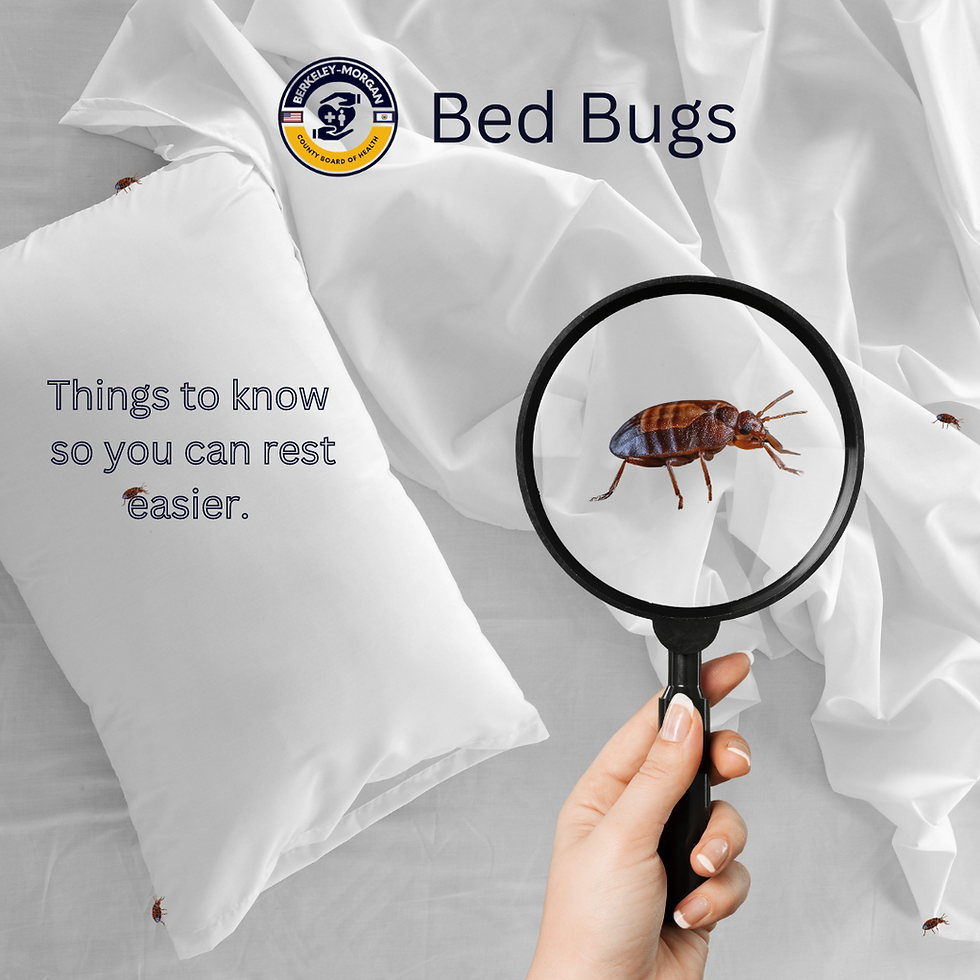Bed Bugs: What you should know to rest easier!
- Health Department
- Mar 15, 2024
- 3 min read
Infromation being shared from the United States Environmental Protection Agency website:
Let's start with some Myth Busting!
Bed Bug Myths
Myth: You can’t see a bed bug. Reality: You should be able to see adult bed bugs, nymphs and eggs with your naked eye.
Myth: Bed bugs live in dirty places. Reality: Bed bugs are not attracted to dirt and grime; they are attracted to warmth, blood and carbon dioxide. However, clutter offers more hiding spots.
Myth: Bed bugs transmit diseases. Reality: There have been no cases or studies that indicate bed bugs transmit diseases between humans.
Myth: Bed bugs are not a public health pest. Reality: Bed bugs are a public health pest. We coordinated with CDC and USDA to identify pests of public health importance and issued a Pesticide Registration Notice that listed pests of significant public health importance. Bed bugs are on this list. In 2009, EPA and CDC collaborated on a joint statement to highlight the public health impacts of bed bugs.
Myth: Bed bugs won’t come out if the room is brightly lit. Reality: While bed bugs prefer darkness, keeping the light on at night won’t deter these pests from biting you.
Myth: Pesticide applications alone will easily eliminate bed bug infestations. Reality: Bed bug control can only be maintained through a treatment strategy that includes a variety of techniques plus careful attention to monitoring. Proper use of pesticides may be part of the strategy, but will not by itself eliminate bed bugs. In addition, bed bug populations in different areas of the country have developed resistance to the ways many pesticides work to kill pests. If you're dealing with a resistant population, some products and application methods may not work. It is a good idea to consult a qualified pest management professional if you have bed bugs in your home.
Myth: EPA has funding available for people who need help with controlling bed bugs. Reality: Unfortunately, EPA does not have funding available to help people with controlling bed bugs. Our roles in the bed bug issue are to:
evaluate pesticides to ensure that when they are used according to label directions, they are effective and will not harm people, non-target species or the environment, and
work with other federal agencies to provide reliable information about bed bugs and their control.
Put out a BOLO (Be On the Look Out) ... But what do they look like??
Adult bed bugs, in general, are:
about the size of an apple seed (5-7 mm or 3/16 - 1/4 inch long);
long and brown, with a flat, oval-shaped body (if not fed recently);
balloon-like, reddish-brown, and more elongated (if fed recently);
a “true bug” (characteristics of true bugs include a beak with three segments; antenna that have four parts; wings that are not used for flying; and short, golden-colored hairs); and
smelly, with a “musty-sweetish” odor produced through glands on the lower side of the body.
Young bed bugs (also called nymphs), in general, are:
smaller, translucent or whitish-yellow in color; and
if not recently fed, can be nearly invisible to the naked eye because of coloring and size.
Bed bug eggs, in general, are:
tiny, the size of a pinhead;
pearl-white in color; and
marked by an eye spot if more than five days old.
For pictures and more information visit: Bed Bugs Appearance and Life Cycle | US EPA
For tips on ways to protect yourself from bed bugs when you are in public places, visit:
For additional information and resources regarding bed bugs visit:



